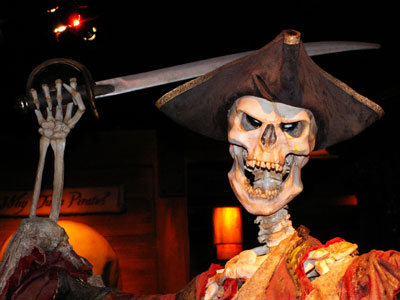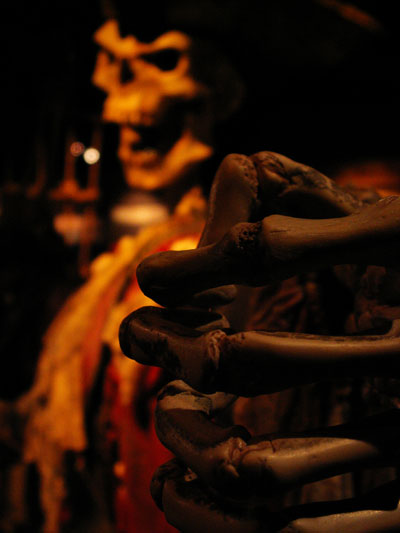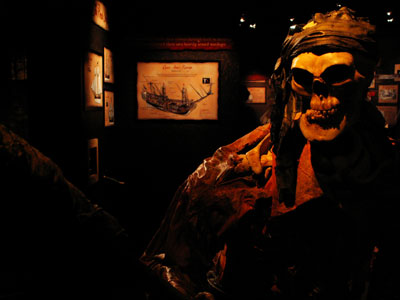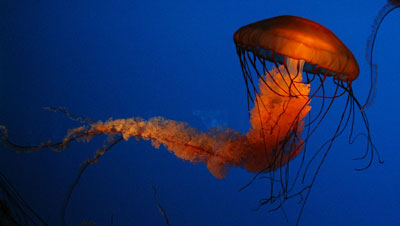


 
 
 
 Photo Essay: Pirates! Sea Monsters!First posted in August, 2006 Photo Essay: Pirates! Sea Monsters!First posted in August, 2006
This photo essay is from our most recent visit to the aquarium in Gatlinburg, Tennessee. It's owned by the Ripley company, who owns a lot of real estate in downtown Gatlinburg these days: a haunted house, a miniature golf course, a 3-D movie theater, the aquarium, and, of course, a gigantic Believe it... or Not! museum. Some things they do well, some things they do make me cringe, all of it is astronomically expensive.
The aquarium is pretty good, I suppose - given its size. But it seems to me that the goal is primarily entertainment, not education or stewardship (which is why I still frequent the Tennessee Aquarium, a three hour drive from Gatlinburg, far more often than I do the local aquarium). To their credit, they do some educational programming, but I guess it's just a holdover from the commercialism of Ripley's and the way they do business that gives it a carnival feel.
Oh, that and they did a big temporary exhibit on pirates.
 But I won't hold it against them - aside from the sinister-looking lads
seemingly inspired by Pirates of the Caribbean, they tried to provide
a more accurate picture of pirates of old. Less praise and romanticism than
is generally seen in such exhibits... more about the crimes they committed.
But I won't hold it against them - aside from the sinister-looking lads
seemingly inspired by Pirates of the Caribbean, they tried to provide
a more accurate picture of pirates of old. Less praise and romanticism than
is generally seen in such exhibits... more about the crimes they committed.
 I must say, as someone who studied human skeletal anatomy at
university, that these are pretty well done, aside from how they
made their eye orbits furrow menacingly - while not anatomically
correct, though, I have to say that the effect is really fantastic.
(Now that I look at the first photograph, though... this guy looks
like he might have more than seven cervical vertebrae, but whatever.)
I must say, as someone who studied human skeletal anatomy at
university, that these are pretty well done, aside from how they
made their eye orbits furrow menacingly - while not anatomically
correct, though, I have to say that the effect is really fantastic.
(Now that I look at the first photograph, though... this guy looks
like he might have more than seven cervical vertebrae, but whatever.)
 And one more shot. Truth be told, I stood there for quite a long time,
waiting for tourist-free backdrops, and I took quite a few shots of these
two skeletons. You're lucky I'm only posting three images...
And one more shot. Truth be told, I stood there for quite a long time,
waiting for tourist-free backdrops, and I took quite a few shots of these
two skeletons. You're lucky I'm only posting three images...
 Phycodurus eques, or leafy sea dragon
A relative of the sea horse, these are one of my favorite
creatures to view at aquariums. Unfortunately, the
understandable demand for them as aquarium specimens
nearly drove them to extinction, but their natural habitat
off the coast of Australia is now protected.
Phycodurus eques, or leafy sea dragon
A relative of the sea horse, these are one of my favorite
creatures to view at aquariums. Unfortunately, the
understandable demand for them as aquarium specimens
nearly drove them to extinction, but their natural habitat
off the coast of Australia is now protected.
 Chrysaora quinquecirrha, or sea nettle
As is standard for most aquarium jellyfish displays,
the blue background and very artificial lighting help
produce contrast that one wouldn't otherwise see.
This shot justified the hassle of carrying the tripod.
Chrysaora quinquecirrha, or sea nettle
As is standard for most aquarium jellyfish displays,
the blue background and very artificial lighting help
produce contrast that one wouldn't otherwise see.
This shot justified the hassle of carrying the tripod.
[ TOP OF THIS PAGE | MORE PHOTOGRAPHY | MORE WRITING | HOME ]


|





 But I won't hold it against them - aside from the sinister-looking lads
seemingly inspired by Pirates of the Caribbean, they tried to provide
a more accurate picture of pirates of old. Less praise and romanticism than
is generally seen in such exhibits... more about the crimes they committed.
But I won't hold it against them - aside from the sinister-looking lads
seemingly inspired by Pirates of the Caribbean, they tried to provide
a more accurate picture of pirates of old. Less praise and romanticism than
is generally seen in such exhibits... more about the crimes they committed.
 I must say, as someone who studied human skeletal anatomy at
university, that these are pretty well done, aside from how they
made their eye orbits furrow menacingly - while not anatomically
correct, though, I have to say that the effect is really fantastic.
(Now that I look at the first photograph, though... this guy looks
like he might have more than seven cervical vertebrae, but whatever.)
I must say, as someone who studied human skeletal anatomy at
university, that these are pretty well done, aside from how they
made their eye orbits furrow menacingly - while not anatomically
correct, though, I have to say that the effect is really fantastic.
(Now that I look at the first photograph, though... this guy looks
like he might have more than seven cervical vertebrae, but whatever.)
 And one more shot. Truth be told, I stood there for quite a long time,
waiting for tourist-free backdrops, and I took quite a few shots of these
two skeletons. You're lucky I'm only posting three images...
And one more shot. Truth be told, I stood there for quite a long time,
waiting for tourist-free backdrops, and I took quite a few shots of these
two skeletons. You're lucky I'm only posting three images...
 Phycodurus eques, or leafy sea dragon
A relative of the sea horse, these are one of my favorite
creatures to view at aquariums. Unfortunately, the
understandable demand for them as aquarium specimens
nearly drove them to extinction, but their natural habitat
off the coast of Australia is now protected.
Phycodurus eques, or leafy sea dragon
A relative of the sea horse, these are one of my favorite
creatures to view at aquariums. Unfortunately, the
understandable demand for them as aquarium specimens
nearly drove them to extinction, but their natural habitat
off the coast of Australia is now protected.
 Chrysaora quinquecirrha, or sea nettle
As is standard for most aquarium jellyfish displays,
the blue background and very artificial lighting help
produce contrast that one wouldn't otherwise see.
This shot justified the hassle of carrying the tripod.
Chrysaora quinquecirrha, or sea nettle
As is standard for most aquarium jellyfish displays,
the blue background and very artificial lighting help
produce contrast that one wouldn't otherwise see.
This shot justified the hassle of carrying the tripod.